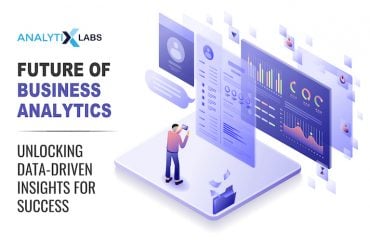The role of a business analyst (BA) is pivotal in modern data-driven companies. BAs are highly valued across diverse sectors, including finance, IT, construction, consulting, commerce, and industry.
IDC reports that spending on BA roles will hit $82 billion in 2024
These specialists can bridge the gap between IT and business, analyze data to assess processes, determine requirements, communicate with customers through virtual numbers online, and deliver data-driven recommendations. If you’re considering a career as an IT business analyst in 2024, our tailor-made courses are just the right option for you to begin your learning journey!
Explore our Business Analytics 360 course and join us for experiential learning that will transform your career. Check out our upcoming batches or book a free demo with us. Also, check out our exclusive enrollment offers
Who is a Business Analyst?
Business Analysts (BAs) link the business and IT, utilizing data analytics to evaluate processes, identify requirements, and provide data-driven suggestions and reports to executives and stakeholders.
BAs collaborate with business leaders and users to explore how data-driven changes to processes, products, services, software, and hardware can enhance efficiency and add value.
They must communicate these ideas effectively while balancing technological feasibility with financial and functional viability. Business Analysts might work with data sets to enhance products, hardware, tools, software, services, or processes, depending on their role.
Why Start a Business Analytics Career?
Business Analysis is a promising and exciting development area for technical professionals. The business analysis market size is estimated at USD 46.33 billion in 2024 to USD 90.67 Billion by 2032, at the CAGR of 8.50% in the forecast period (2024-2029).
Therefore, it is worth starting now if you are interested in this field. Here we have described several reasons why you might consider a business analytics career
in 2024 from scratch:

-
Growing Role in the Organization
Business Analysts are crucial in helping organizations process information, improve efficiency, and achieve strategic goals. As companies increasingly use data to make informed decisions, the need for skilled business analysts is growing.
-
Diverse Industries and Opportunities
Business Analysts are needed across various industries, including finance, healthcare, technology, retail, and government. This diversity allows you to choose a sector that aligns with your interests and expertise, providing ample opportunities for career growth and specialization. Whether you’re passionate about healthcare analytics or financial analysis, there’s a niche for you in the business analysis field.
-
Competitive Salaries and Benefits
The demand translates into competitive salaries and attractive compensation packages. Entry-level business analysts can expect to earn a substantial salary, with significant potential for increases as they gain experience and advance in their careers.
In 2024, the average salary for a Business Analyst in India can vary depending on the level of experience, region of the country, and specialization. Here are the average estimates:
- Junior Business Analyst: Around Rs 3 to 5 lakh rupees per annum. That’s about $3,500 to $6,000 per year.
- Middle-level Business Analyst: Between Rs 6 lakh to 12 lakh per annum. That’s approximately $8,000 to $16,000 per year.
- Senior Business Analyst: 12 to 20 lakh rupees per annum. That’s approximately $16,000 to $27,000 per year.
With experience and certifications, you can move into senior roles such as senior business analyst, project manager, or head of the business analysis department. These positions often come with increased responsibilities, higher salaries, and organizational influence.
-
Flexible Work Arrangements
Many business analyst roles offer flexible work arrangements, including remote work options and flexible hours. This flexibility allows you to achieve an excellent work-life balance, accommodate personal commitments, and reduce stress.
In the contemporary environment, where ensuring a balanced work-life dynamic is essential for one’s overall well-being, working on a flexible schedule holds significant value.
How to Become a Business Analyst in 2024?
Firstly, you need to determine the specifics of business analyst jobs in the companies you want to work for and understand the primary responsibilities.

Step 1: Understand the Role
According to the BABoK Guide’s core, “Business analysis is the practice of enabling change in an enterprise by identifying needs and recommending solutions that will benefit stakeholders”.
Sometimes, a BA’s work is supplemented by a Systems Analyst’s tasks. This does not mean that the specialists are interchangeable, but their areas of responsibility may overlap. The key responsibilities of a BA are:
- Requirement Gathering: Identifying business needs and requirements through various methods such as interviews, surveys, webinars, and workshops.
- Data Analysis: Analyzing a lot of data to draw insights and make informed business decisions, based on real numbers.
- Writing Documentation: Creating detailed documentation such as business requirement documents (BRDs), functional requirement documents (FRDs), and use cases.
- Process Improvement: Recommending changes to improve business processes and efficiency from a new level.
- Stakeholder Communication: Liaising between the business side and the IT side to ensure seamless communication and project alignment.
Step 2: Learn Soft Skills
You’ll need a blend of technical, hard, and soft skills to have a successful business analytics career. Quite often, a good specialist is hired precisely for soft skills. Such shows how you will communicate with the team and the customer in the future. That’s what distinguishes the soft skills of a good BA:
- Broad Outlook
Knowledge of subject areas and the specifics of different types of activities allows you to immerse yourself in a project faster and speak the same language as the client. It would be best if you also kept in mind patterns of problem-solving that can be reused in projects.
- Communication Skills
If you have difficulty communicating with people and conveying information clearly, you need to polish your communication skills. However, there is a classification that includes business analysts and system analysts.
It is believed that the former communicates more with people and works with documents. This division is rare. In large outsourcing companies, a business analyst and a systems analyst are the same people.
- Developed Empathy
The ability to look at a problem from different perspectives, understand how the customer and the end user feel, and look at the problem statement through the eyes of the team—developers, testers, designers, and management—helps to consider many potential difficulties, questions and wishes.
Step 3: Master Hard Skills
Mastering hard skills will enable you to do practical data analysis, process optimization, and clear communication of technical information. These skills are crucial for translating business needs into actionable insights and ensuring the successful implementation of business solutions. So, the vital hard skills should be in:

1. Data Analysis
Proficiency in data analysis techniques and tools is crucial for a BA. This includes:
- SQL (Structured Query Language): Proficiency in SQL (for example, MySQL) is essential for querying and extracting data from databases. BAs must be able to write complex queries to retrieve, manipulate, and analyze large datasets efficiently.
- Excel: Advanced skills in Excel are necessary for data manipulation, analysis, and visualization. BAs use Excel to create pivot tables, perform statistical analysis, and generate reports that support decision-making processes.
- Python: Knowledge of programming languages (Python, Java, C#) is beneficial for performing data analysis, statistical modeling, and predictive analytics. These languages offer potent libraries and tools for data manipulation and visualization.
Also read:
2. Business Intelligence (BI)
Familiarity with BI tools is essential for visualizing data and creating actionable insights.
- Tableau: Expertise in Tableau is essential for creating interactive and visually appealing dashboards and reports. BAs use Tableau to transform raw data into meaningful visualizations highlighting key trends and insights.
- Power BI: Power BI is a robust tool for data visualization and business intelligence. BAs leverage Power BI to design dynamic reports and dashboards that provide real-time data analysis and insights.
- Qlik: Familiarity with Qlik products (e.g., QlikView, Qlik Sense) enables BAs to develop data discovery and visualization solutions that facilitate informed decision-making.
Also read: Business Intelligence vs. Business Analytics
3. Collaboration Tools
Most of these tools are needed to keep all customer correspondence in one place. Also, by using such tools, data confidentiality is preserved. Key tools:
- Microsoft Teams: A platform for chat, video meetings, file storage, and application integration, facilitating real-time collaboration and communication.
- Slack: A messaging app for teams that allows real-time communication, file sharing, and integration with various project management tools and applications.
- Zoom: A video conferencing tool for virtual meetings, webinars, and screen sharing, essential for remote collaboration.
- Google Meet: A video communication service developed by Google for virtual meetings and collaborations.
4. Requirements Gathering and Management
Ability to gather, document, and manage business requirements effectively using tools like:
- JIRA: Proficiency in JIRA is essential for tracking and managing requirements, user stories, and tasks throughout the project lifecycle. BAs use JIRA to ensure that all project requirements are documented, prioritized and tracked to completion.
- Confluence: Knowledge of Confluence is essential for creating, sharing, and managing project documentation. BAs use Confluence to collaborate with stakeholders, document requirements, and maintain project information in a centralized location.
- Jama Connect: This tool is particularly employed for complex projects with numerous stakeholders and interdependencies.
5. Process Modeling and Improvement
Skills in modeling current and future business processes to identify inefficiencies and recommend improvements. Tools may include:
- BPMN: Understanding BPMN is crucial for modeling business processes and workflows. BAs use BPMN to create detailed process maps that identify inefficiencies and opportunities for improvement.
- Workflow Diagrams: Proficiency in creating workflow diagrams helps BAs visually represent business processes, systems, and data flows. These diagrams clearly understand current processes and support optimized workflow design.
6. Software Development Life Cycle (SDLC)
Understanding different phases of SDLC (e.g., Agile, Waterfall) and how they impact project delivery:
- Agile Methodologies: Knowledge of Agile methodologies, such as Scrum and Kanban, is essential for BAs working in fast-paced development environments. Agile methodologies emphasize iterative development, continuous feedback, and collaboration between cross-functional teams.
- Waterfall Methodology: Understanding the Waterfall is essential for projects that follow a sequential design process. BAs must be able to manage requirements and ensure that each phase of the project is completed before moving on to the next.
7. Statistical Analysis and Modeling
Knowledge of statistical methods and techniques for data analysis and predictive modeling:
- Regression Analysis: Proficiency in regression analysis is essential for understanding relationships between variables and making predictions based on historical data. BAs use regression analysis to identify trends, forecast outcomes, and support strategic decision-making.
- Predictive Analytics: Knowledge of predictive analytics techniques enables BAs to use statistical algorithms, data, and machine learning models to identify the possibility of future outcomes This skill is essential for developing data-driven strategies and recommendations.
Also read:
8. Software Documentation
Ability to create comprehensive technical documents and reports that communicate findings and recommendations clearly to stakeholders:
- Business Requirement Document: The ability to create detailed BRDs is crucial for defining business needs, objectives, and requirements. BAs use BRDs to ensure all stakeholders understand the project’s scope and goals clearly.
- Functional Requirement Document (FRD): Expertise in writing FRDs is essential for detailing system functionalities based on business requirements. FRDs provide developers and technical teams with the information to design and implement solutions that meet business needs.
By mastering these hard skills, business analysts can effectively bridge the gap between technical solutions and business objectives, driving organizational success through data-driven insights and strategic recommendations.
These skills enable BAs to analyze complex data, optimize business processes, and communicate technical information clearly, ensuring the successful implementation of business initiatives.
Step 4: Read Books and Watch Tutorials
1) “BABOK” (“Business Analysis Body of Knowledge”)
BABOK (Business Analysis Body of Knowledge) is a fundamental resource for any business analyst. It is the brainchild of the International Institute of Business Analysis (IIBA), the most reputable association in our field.
BABOK is the “bible” of BA, providing an in-depth understanding of professional standards. The book describes a comprehensive set of knowledge required to conduct analysis effectively across multiple industries and levels.
2) “Software Requirements” by Karl Wiegers
This book is a detailed guide to developing quality software requirements. It describes dozens of proven techniques for identifying, formulating, developing, validating, verifying, validating, and testing requirements to help developers, managers, and marketers create compelling software. This edition is updated with new techniques for requirements development in agile projects.
3) “Agile Software Requirements” by Dean Leffingwell
The author combines 3 approaches: classical management practices, Agile methods, and lean manufacturing to offer a practical methodology for understanding and managing software requirements.
4) “System Thinking” by Joseph O’Connor
The methods and principles of holistic understanding of complex systems, the properties whose behavior is determined by the nature of the links between their components, and the perceptions of the people involved in them. This is for readers who want to develop a systemic worldview and learn to solve complex problems in various fields.
Step 5: Gain Practical Experience
-
Create a CV
Begin your business analytics career as a junior business analyst or data analyst to gain hands-on experience. Create a CV/ portfolio showcasing your projects, case studies, and achievements. Highlight your problem-solving skills and the impact of your analyses on business outcomes. BA roles involve assisting senior analysts, conducting research, and participating in requirements-gathering sessions.
-
Volunteer
If finding a business analyst jobs are difficult, you can get internships or volunteer to gain practical experience and build your portfolio. Non-profit organizations and small businesses often offer opportunities to work on real-world projects.
You can also participate in industry conferences, webinars, and workshops to stay updated with industry trends, best practices, and networking opportunities. Join LinkedIn groups, forums, and social media communities dedicated to business analysis to connect with peers, share insights, and learn from industry experts.
-
Prepare for Interviews
Familiarize yourself with the company and industry trends. You should be ready to discuss how your skills align with their business objectives. Prepare for common BA interview questions and scenarios. Use mock interviews to refine your responses and build confidence.
More blogs on Interview Series :Conclusion
Business Analysts are crucial as companies increasingly rely on data for decision-making. A career in business analysis offers diverse opportunities, competitive salaries, and flexible work arrangements.
Aspiring BAs should develop both soft and hard skills, including data analysis, business intelligence, and effective communication. Mastery of tools like SQL, Tableau, and JIRA, along with understanding Agile and Waterfall methodologies, is essential. Gaining practical experience through internships and continuous learning will further enhance your expertise.
By following the outlined steps and leveraging available resources, you can develop the business analyst learning path in 2024 and beyond, contributing significantly to your organization’s strategic goals and efficiency.
FAQs
- What kind of education can I get to then work as a business analyst?
- Bachelor’s Degree: A bachelor’s degree in finance, business administration, computer science, or any related field is often required. Courses in statistics, economics, and management can be particularly beneficial.
- Master’s Degree: A master’s degree in business administration (MBA) or management information systems (MIS) can provide an edge in the competitive job market.
- What are the world certifications for BAs?
Certifications can enhance your credentials and demonstrate your expertise to potential employers. The world-famous certifications for BAs are:
- Certified Business Analysis Professional (CBAP): The International Institute of Business Analysis (IIBA) offers this certification, which is one of the most recognized certifications in the field.
- Project Management Professional (PMP): While primarily a project management certification, PMP can benefit business analysts involved in project management.
- Agile Analysis Certification (AAC): Also offered by IIBA, this certification is ideal for business analysts working in Agile environments.
- What industries employ Business Analysts?
Business Analysts are employed across various industries, including finance, healthcare, technology, retail, manufacturing, and government sectors. Each industry has unique requirements and challenges, making the role of a BA versatile and in demand.
Becoming a business analyst in 2024 is a rewarding career path that offers numerous professional growth and development opportunities. By acquiring the necessary education, gaining practical experience, and continuously working on your skills, you will be able to succeed in this dynamic field.








